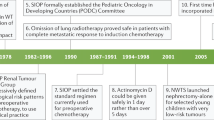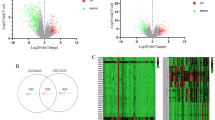Abstract
Chromosome 7p alterations have been implicated in the development of Wilms’ tumour (WT) by previous studies of tumour cytogenetics, and by our analysis of a constitutional translocation (t(1;7)(q42;p15)) in a child with WT and radial aplasia. We therefore used polymorphic microsatellite markers on 7p for a loss of heterozygosity (LOH) study, and found LOH in seven out of 77 informative WTs (9%). The common region of LOH was 7p15–7p22, which contains the region disrupted by the t(1;7) breakpoint. Four WTs with 7p LOH had other genetic changes; a germline WT1 mutation with 11p LOH, LOH at 11p, LOH at 16q, and loss of imprinting of IGF2. Analysis of three tumour-associated lesions from 7p LOH cases revealed a cystic nephroma-like area also having 7p LOH. However, a nephrogenic rest and a contralateral WT from the two other cases showed no 7p LOH. No particular clinical phenotype was associated with the WTs which showed 7p LOH. The frequency and pattern of 7p LOH demonstrated in our studies indicate the presence of a tumour suppressor gene at 7p involved in the development of Wilms’ tumour. © 2000 Cancer Research Campaign
Similar content being viewed by others
Article PDF
Change history
16 November 2011
This paper was modified 12 months after initial publication to switch to Creative Commons licence terms, as noted at publication
References
Austruy E, Candon S, Henry I, Gyapay G, Tournade MF, Mannens M, Callen D, Junien C and Jeanpierre C (1995) Characterization of regions of chromosomes 12 and 16 involved in nephroblastoma tumorigenesis. Genes Chromosomes Cancer 14: 285–294
Beckwith JB, Kiviat NB and Bonadio JF (1990) Nephrogenic rests, nephroblastomatosis, and the pathogenesis of Wilms’ tumor. Pediatr Pathol 10: 1–36
Brown KW, Villar AJ, Bickmore W, ClaytonSmith J, Catchpoole D, Maher ER and Reik W (1996) Imprinting mutation in the Beckwith-Wiedemann syndrome leads to biallelic IGF2 expression through an H19-independent pathway. Hum Mol Genet 5: 2027–2032
Call KM, Glaser T, Ito CY, Buckler AJ, Pelletier J, Haber DA, Rose EA, Kral A, Yeger H and Lewis WH (1990) Isolation and characterization of a zinc finger polypeptide gene at the human chromosome 11 Wilms’ tumor locus. Cell 60: 509–520
Charles AK, Brown KW and Berry PJ (1998 a) Microdissecting the genetic events in nephrogenic rests and Wilms’ tumor development. Am J Pathol 153: 991–1000
Charles AK, Vujanic GM and Berry PJ (1998 b) Renal tumours of childhood. Histopathology 32: 293–309
Chumakov IM, Rigault P, Legall I, Bellannechantelot C, Billault A, Guillou S, Soularue P, Guasconi G, Poullier E, Gros I, Belova M, Sambucy JL, Susini L, Gervy P, Glibert F, Beaufils S, Bui H, Massart C, Detand MF, Dukasz F, Lecoulant S, Ougen P, Perrot V, Saumler M, Soravito C, Bahouayila R, Cohenakenine A, Barillot E, Bertrand S, Codani JJ, Caterina D, Georges I, Lacroix B, Lucotte G, Sahbatou M, Schmit C, Sangouard M, Tubacher E, Dib C, Faure S, Fizames C, Gyapay G, Millasseau P, Nguyen S, Muselet D, Vignal A, Morissette J, Menninger J, Lieman J, Desai T, Banks A, Brayward P, Ward D, Hudson T, Gerety S, Foote S, Stein L, Page DC, Lander ES, Weissenbach J, Lepaslier D and Cohen D (1995) A YAC contig map of the human genome. Nature 377: 175–298
Coppes MJ, Campbell CE and Williams BRG (1995) Wilms Tumor: Clinical and Molecular Characterisation. RG Landes: Austin, Texas
Dib C, Faure S, Fizames C, Samson D, Drouot N, Vignal A, Millasseau P, Marc S, Hazan J, Seboun E, Lathrop M, Gyapay G, Morissette J and Weissenbach J (1996) A comprehensive genetic map of the human genome based on 5,264 microsatellites. Nature 380: 152–154
Fearon ER and Vogelstein B (1990) A genetic model for colorectal tumorigenesis. Cell 61: 759–767
Fletcher JA and Renshaw AA (1996) Isochromosome 7q in adult Wilms’ tumor. Cancer Genet Cytogenet 86: 168–169
Franke U, Holmes LB, Atkins L and Riccardi VM (1979) Aniridia Wilms’ tumor association: evidence for specific deletion of 11p13. Cytogenet Cell Genet 24: 185–192
Gessler M, Poustka A, Cavenee W, Neve RL, Orkin SH and Bruns GA (1990) Homozygous deletion in Wilms tumours of a zinc-finger gene identified by chromosome jumping. Nature 343: 774–778
Grundy PE, Telzerow PE, Breslow N, Moksness J, Huff V and Paterson MC (1994) Loss of heterozygosity for chromosomes 16Q and 1P in Wilms’ tumors predicts an adverse outcome. Cancer Res 54: 2331–2333
Grundy RG, Pritchard J, Scambler P and Cowell JK (1998) Loss of heterozygosity for the short arm of chromosome 7 in sporadic Wilms’ tumour. Oncogene 17: 395–400
Hastie ND (1994) The genetics of Wilms’ tumor – a case of disrupted development. Annu Rev Genet 28: 523–558
Hearne CM, Ghosh S and Todd JA (1992) Microsatellites for linkage analysis of genetic traits. Trend Genet 8: 288–294
Hewitt M, Lunt PW and Oakhill A (1991) Wilms’ tumour and a de novo (1;7) translocation in a child with bilateral radial aplasia. J Med Genet 28: 411–412
Huang A, Campbell CE, Bonetta L, McAndrews Hill MS, Chilton MacNeill S, Coppes MJ, Law DJ, Feinberg AP, Yeger H and Williams BR (1990) Tissue, developmental, and tumor-specific expression of divergent transcripts in Wilms’ tumor. Science 250: 991–994
Huff V and Saunders GF (1993) Wilms’ tumor genes. Biochim Biophys Acta 1155: 295–306
Kaneko Y, Homma C, Maseki N, Sakurai M and Hata J (1991) Correlation of chromosome abnormalities with histological and clinical features in Wilms’ and other childhood renal tumors. Cancer Res 51: 5937–5942
Keen TJ, Inglehearn CF, Green ED, Cunningham AF, Patel RJ, Peacock RE, Gerken S, White R, Wessenbach J and Bhattacharya SS (1995) YAC contig spanning the dominant retinitis pigmentosa locus (RP9) on chromosome 7p. Genomics 28: 383–388
Knudson AG and Strong LC (1972) Mutation and cancer: a model for Wilms’ tumour of the kidney. J Natl Cancer Inst 48: 313–324
Lahoti C, Thorner P, Malkin D and Yeger H (1996) Immunohistochemical detection of p53 in Wilms’ tumors correlates with unfavorable outcome. Am J Pathol 148: 1577–1589
Lobbert RW, Klemm G, Gruttner HP, Harms D, Winterpacht A and Zabel BU (1998) Novel WT1 mutation, 11p LOH, and t(7;12) (p22;q22) chromosomal translocation identified in a Wilms’ tumor case. Genes Chromosomes Cancer 21: 347–350
McDonald JM, Douglass EC, Fisher R, Geiser CF, Krill CE, Strong LC, Virshup D and Huff V (1998) Linkage of familial Wilms’ tumor predisposition to chromosome 19 and a two-locus model for the etiology of familial tumors. Cancer Res 58: 1387–1390
Maitland NJ, Cox MF, Lynas C, Prime SS, Meanwell CA and Scully C (1987) Detection of human papillomavirus DNA in biopsies of human oral tissue. Br J Cancer 56: 245–250
Malkin D, Sexsmith E, Yeger H, Williams BRG and Coppes MJ (1994) Mutations of the p53 tumor suppressor gene occur infrequently in Wilms’ tumor. Cancer Res 54: 2077–2079
Maw MA, Grundy PE, Millow LJ, Eccles MR, Dunn RS, Smith PJ, Feinberg AP, Law DJ, Paterson MC, Telzerow PE, Callen DF, Thompson AD, Richards RI and Reeve AE (1992) A 3rd Wilms’ tumor locus on chromosome-16q. Cancer Res 52: 3094–3098
Mellersh C and Sampson J (1993) Simplifying the detection of microsatellite length polymorphisms. Biotechniques 15: 582–584
Miozzo M, Perotti D, Minoletti F, Mondini P, Pilotti S, Luksch R, Fossatibellani F, Pierotti MA, Sozzi G and Radice P (1996) Mapping of a putative tumor suppressor locus to proximal 7p in Wilms’ tumors. Genomics 37: 310–315
Miyagawa K, Kent J, Moore A, Charlieu J, Little M, Williamson KA, Kelsey A, Brown KW, Hassam S, Briner J, Hayashi Y, Hirai H, Yazaki Y, van Heyningen V and Hastie ND (1998) Loss of WT1 function leads to ectopic myogenesis in Wilms’ tumor. Nat Genet 18: 15–17
Ogawa O, Eccles MR, Szeto J, Mcnoe LA, Yun K, Maw MA, Smith PJ and Reeve AE (1993) Relaxation of insulin-like growth factor-II gene imprinting implicated in Wilms’ tumor. Nature 362: 749–751
Park S, Bernard A, Bove KE, Sens DA, Hazen-Martin DJ, Garvin AJ and Haber DA (1993) Inactivation of WT1 in nephrogenic rests, genetic precursors to Wilms’ tumour. Nat Genet 5: 363–367
Peier AM, Meloni AM, Erling MA and Sandberg AA (1995) Involvement of chromosome 7 in Wilms’ tumor. Cancer Genet Cytogenet 79: 92–94
Ping AJ, Reeve AE, Law DJ, Young MR, Boehnke M and Feinberg AP (1989) Genetic linkage of Beckwith–Wiedemann syndrome to 11p15. Am J Hum Genet 44: 720–723
Radice P, Perotti D, Debenedetti V, Mondini P, Radice MT, Pilotti S, Luksch R, Bellani FF and Pierotti MA (1995) Allelotyping in Wilms’ tumors identifies a putative third tumor suppressor gene on chromosome 11. Genomics 27: 497–501
Rahman N, Arbour L, Tonin P, Renshaw J, Pelletier J, Baruchel S, Pritchardjones K, Stratton MR and Narod SA (1996) Evidence for a familial Wilms’ tumour gene (FWT1) on chromosome 17q12–q21. Nat Genet 13: 461–463
Rainier S, Johnson LA, Dobry CJ, Ping AJ, Grundy PE and Feinberg AP (1993) Relaxation of imprinted genes in human cancer. Nature 362: 747–749
Reeve AE, Sih SA, Raizis AM and Feinberg AP (1989) Loss of allelic heterozygosity at a second locus on chromosome 11 in sporadic Wilms’ tumor cells. Mol Cell Biol 9: 1799–1803
Reik W and Maher ER (1997) Imprinting in clusters: lessons from Beckwith-Wiedemann syndrome. Trend Genet 13: 330–334
Reynolds PA, Powlesland RM, Keen TJ, Inglehearn CF, Cunningham AF, Green ED and Brown KW (1996) Localization of a novel t(1:7) translocation associated with Wilms’ tumor predisposition and skeletal abnormalities. Genes Chromosomes Cancer 17: 151–155
Rivera H (1995) Constitutional and acquired rearrangements of chromosome 7 in Wilms’ tumor. Cancer Genet Cytogenet 81: 97–98
Rivera H, Ruiz C, Garcia Cruz D, Rolon A, Arroyo J and Cantu JM (1985) Constitutional mosaic t(2;7)(q33;p22) and other rearrangements in a girl with Wilms’ tumor. Ann Genet 28: 52–54
Sawyer JR, Winkel EW, Redman JF and Roloson GJ (1993) Translocation (7;7)(p13;q21) in a Wilms’ tumor. Cancer Genet Cytogenet 69: 57–59
Sheffield VC, Weber JL, Buetow KH, Murray JC, Even DA, Wiles K, Gastier JM, Pulido JC, Yandava C, Sunden SL, Mattes G, Businga T, Mcclain A, Beck J, Scherpier T, Gilliam J, Zhong J and Duyk GM (1995) A collection of tri- and tetranucleotide repeat markers used to generate high quality, high resolution human genome-wide linkage maps. Hum Mol Genet 4: 1837–1844
Solis V, Pritchard J and Cowell JK (1988) Cytogenetic changes in Wilms’ tumors. Cancer Genet Cytogenet 34: 223–234
Steenman M, Redeker B, De Meulemeester M, Wiesmeijer K, Voute PA, Westerveld A, Slater R and Mannens M (1997) Comparative genomic hybridization analysis of Wilms’ tumors. Cytogenet Cell Genet 77: 296–303
Wang-Wuu S, Soukup S, Bove B, Gotwals B and Lampkin B (1990) Chromosomal analysis of 31 Wilms’ tumors. Cancer Res 50: 2786–2793
Weber JL, Kwitek AE and May PE (1990) Dinucleotide repeat polymorphisms at the D16S260, D16S261, D16S265, D16S266, and D16S267 loci. Nucleic Acids Res 18: 4034
Wilmore HP, White GFJ, Howell RT and Brown KW (1994) Germline and somatic abnormalities of chromosome 7 in Wilms’ tumor. Cancer Genet Cytogenet 77: 93–98
Author information
Authors and Affiliations
Rights and permissions
From twelve months after its original publication, this work is licensed under the Creative Commons Attribution-NonCommercial-Share Alike 3.0 Unported License. To view a copy of this license, visit http://creativecommons.org/licenses/by-nc-sa/3.0/
About this article
Cite this article
Powlesland, R., Charles, A., Malik, K. et al. Loss of heterozygosity at 7p in Wilms’ tumour development. Br J Cancer 82, 323–329 (2000). https://doi.org/10.1054/bjoc.1999.0922
Received:
Revised:
Accepted:
Published:
Issue date:
DOI: https://doi.org/10.1054/bjoc.1999.0922
Keywords
This article is cited by
-
Overexpression of HDAC9 promotes oral squamous cell carcinoma growth, regulates cell cycle progression, and inhibits apoptosis
Molecular and Cellular Biochemistry (2016)
-
High-resolution genomic profiling of an adult Wilms’ tumor: evidence for a pathogenesis distinct from corresponding pediatric tumors
Virchows Archiv (2011)
-
Loss of heterozygosity and SOSTDC1 in adult and pediatric renal tumors
Journal of Experimental & Clinical Cancer Research (2010)
-
Candidate genes and potential targets for therapeutics in Wilms’ tumour
Clinical and Translational Oncology (2010)
-
The parathyroid hormone-responsive B1 gene is interrupted by a t(1;7)(q42;p15) breakpoint associated with Wilms' tumour
Oncogene (2003)



